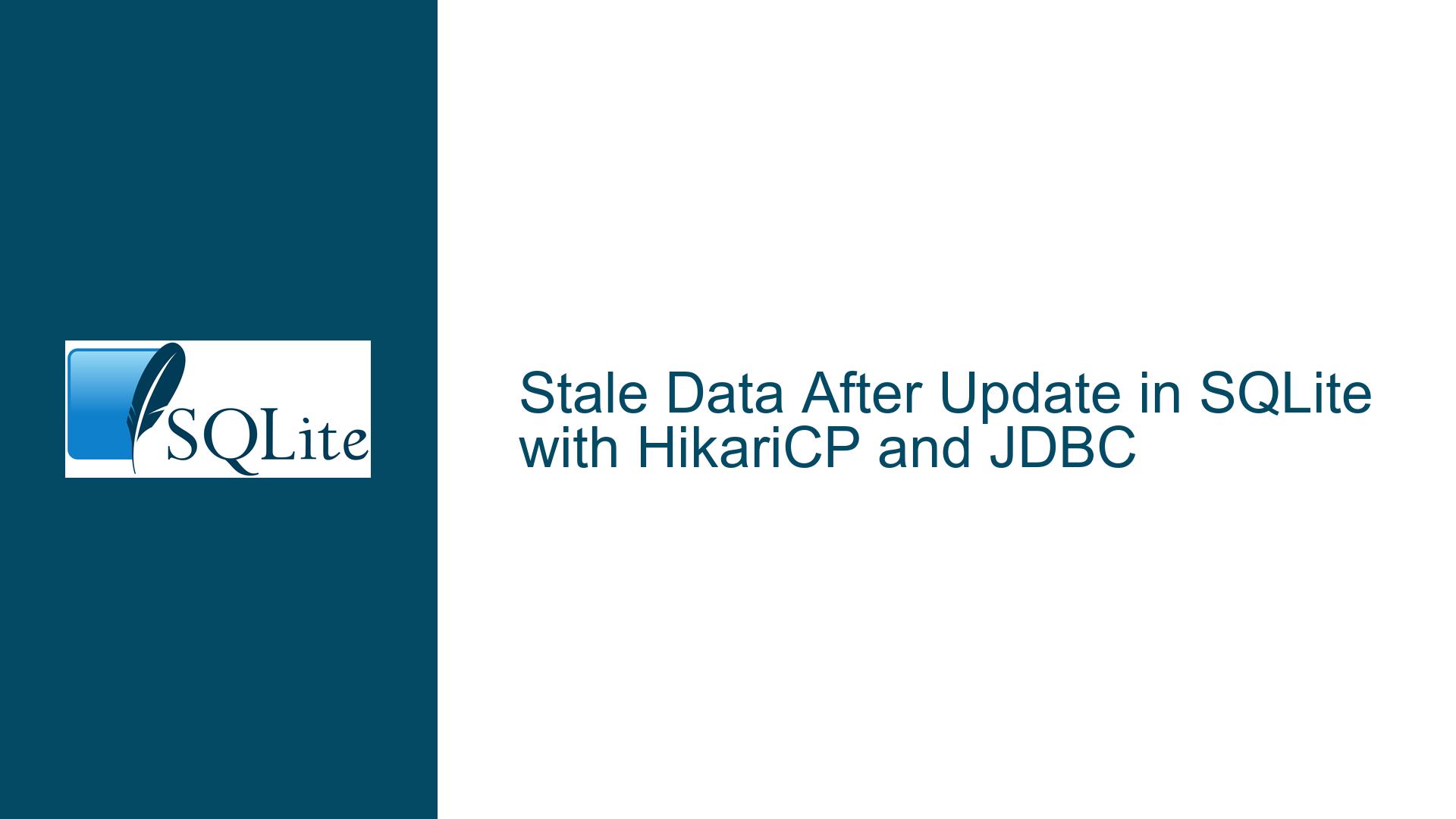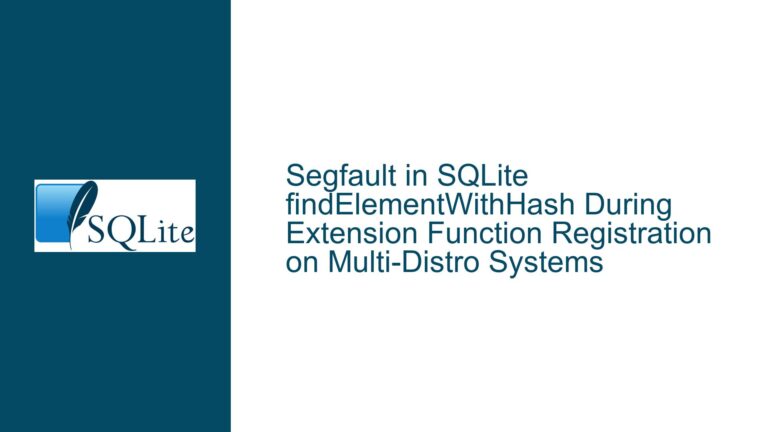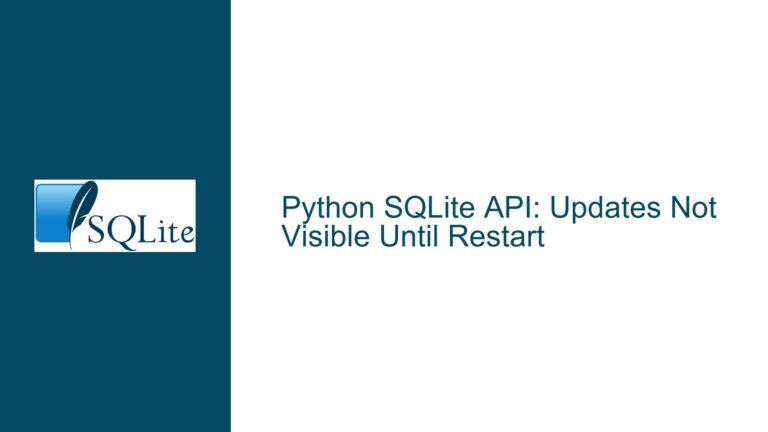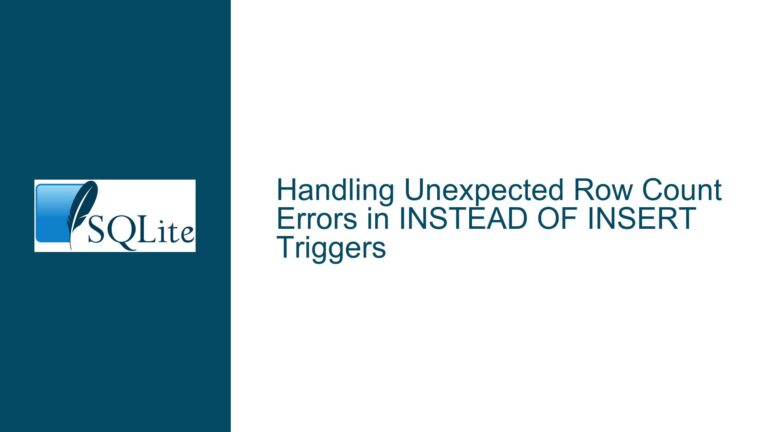Stale Data After Update in SQLite with HikariCP and JDBC
Transaction Commit Delays Causing Stale SELECT Results in SQLite via JDBC
Connection Lifecycle, Transaction Isolation, and Visibility in SQLite-JDBC Environments
1. Delayed Visibility of Committed Changes Across JDBC Connections
The core issue involves updates made to an SQLite database via a JDBC connection not being immediately visible to subsequent SELECT queries executed through separate connections managed by HikariCP. This manifests as stale data being returned until a delay (e.g., 1-second sleep) is introduced between the UPDATE and SELECT operations. The problem arises from interactions between SQLite’s transaction handling, JDBC driver behavior, and connection pool configuration. Key components include:
- SQLite’s Transaction Model: By default, SQLite uses serializable isolation with immediate visibility of committed changes to new transactions. However, this guarantee applies only when connections properly honor transaction boundaries and write-ahead logging (WAL) or rollback journal synchronization.
- JDBC Connection Pooling: HikariCP reuses physical connections, which may retain transaction state or cached data if not reset properly.
- Driver-Specific Behavior: The SQLite-JDBC driver (e.g., org.xerial:sqlite-jdbc) implements connection handling and transaction isolation in ways that may conflict with connection pool expectations.
The crux lies in how these layers interact when handling concurrent read/write operations. For instance, a connection used for an UPDATE may commit changes, but a subsequent connection borrowed from the pool for a SELECT might not see those changes due to:
- Unflushed Write Buffers at the OS/filesystem level.
- Cross-Connection Transaction Visibility Rules in SQLite’s journaling modes.
- Stale Read Transactions left open by the JDBC driver or connection pool.
- Misconfigured Connection Pool settings that bypass transaction completion.
2. Journaling Modes, Connection Pool Misconfigurations, and Transaction Scope Leaks
A. SQLite Journaling Mode and Synchronization Settings
SQLite’s journal mode (DELETE, TRUNCATE, PERSIST, WAL) and synchronous pragma (FULL, NORMAL, OFF) directly influence when changes become visible to other connections:
- DELETE/TRUNCATE/PERSIST Modes: Require exclusive locks during writes, forcing readers to wait until commits complete. However, readers started before a commit may see older data.
- WAL Mode: Allows concurrent readers and writers, but readers see a snapshot of the database as of their first read operation. New connections see the latest committed changes immediately.
- Synchronous=FULL: Ensures all writes are flushed to disk before a transaction completes, guaranteeing visibility to new connections. Synchronous=NORMAL/OFF introduces risks of data being cached at the OS level, delaying visibility.
If the database uses WAL mode with synchronous=NORMAL, a SELECT connection might read from the WAL file before the UPDATE’s changes are fully flushed. This is exacerbated by connection pools that rapidly recycle connections without allowing time for filesystem synchronization.
B. HikariCP Configuration Pitfalls
HikariCP defaults to auto-commit=true, which should commit each statement immediately. However, misconfigurations can override this:
connectionInitSqlexecutingPRAGMA journal_mode=WALorPRAGMA synchronous=OFFwithout proper validation.isolationLevelsettings that conflict with SQLite’s default (e.g.,TRANSACTION_REPEATABLE_READ, which SQLite does not support).- Leaked Transactions: Connections returned to the pool with uncommitted transactions or active read statements, causing subsequent users to inherit stale snapshots.
C. JDBC Driver Caching and Transaction Management
The SQLite-JDBC driver has known edge cases:
- Statement Caching: Prepared statements may cache query plans that bypass newer data.
- Implicit Transaction Handling: Auto-commit toggling can create nested transactions that delay visibility.
- Shared Cache Misuse: Enabling
shared_cachemode without proper synchronization can lead to cross-connection staleness.
3. Validating Commit Integrity, Forcing WAL Synchronization, and Resetting Pooled Connections
Step 1: Verify Transaction Commit Integrity
- Explicit Commit Check: Add manual commits after
executeUpdate()and before closing the connection:try (Connection conn = getDatabaseConnection(); PreparedStatement updateStatement = ...) { updateStatement.executeUpdate(); conn.commit(); // Explicit commit even with auto-commit=true } - Enable SQLite Trace Logging: Use
sqlite3_trace_v2()or JDBC driver hooks to log all transactions and confirm commits are issued.
Step 2: Configure SQLite for Immediate Visibility
- Set Synchronous=FULL:
PRAGMA synchronous=FULL;Apply this at connection initialization via HikariCP’s
connectionInitSql. - Disable WAL Mode Temporarily: Test with
PRAGMA journal_mode=DELETEto rule out WAL snapshot issues. - Force Checkpoint in WAL Mode: After commits, execute
PRAGMA wal_checkpoint(FULL);to flush WAL changes to the main database.
Step 3: Audit HikariCP Connection Lifecycle
- Set
autoCommit=trueExplicitly:datasources: default: hikari: auto-commit: true - Invalidate Stale Connections: Configure
maxLifetimeto 30000 ms (30 seconds) to force periodic reconnection. - Reset Connections Before Use: Add a validation query like
SELECT 1to reset transaction state:datasources: default: hikari: connection-test-query: SELECT 1
Step 4: Isolate Writes and Reads on the Same Connection
If feasible, reuse the same physical connection for UPDATE and subsequent SELECT operations:
try (Connection conn = getDatabaseConnection();
PreparedStatement updateStmt = ...;
PreparedStatement selectStmt = ...) {
updateStmt.executeUpdate();
conn.commit();
// Execute SELECT within the same connection
ResultSet rs = selectStmt.executeQuery();
}
Step 5: Upgrade and Diagnose JDBC Driver Issues
- Use Latest SQLite-JDBC Driver: Older versions (e.g., pre-3.36) have bugs in transaction handling.
- Enable Driver Debug Logging: Configure logging for
org.sqliteto trace connection states.
Step 6: Filesystem and OS-Level Synchronization
- Disable Filesystem Caching: On Linux, mount the database directory with
syncordirectiooptions. - Use In-Memory Databases for Testing: Confirm if the issue persists with
jdbc:sqlite::memory:to isolate filesystem delays.
Step 7: Application-Level Workarounds
- Introduce Controlled Retries: Implement exponential backoff for SELECT queries after UPDATEs.
- Use UTC Timestamps or Version Columns: Manually track changes and include these in WHERE clauses to detect staleness.
Final Validation
If all else fails, bypass HikariCP temporarily:
try (Connection conn = DriverManager.getConnection("jdbc:sqlite:file.db");
PreparedStatement stmt = conn.prepareStatement(...)) {
// Execute UPDATE and SELECT
}
This isolates whether the issue stems from HikariCP configuration or deeper JDBC/SQLite interactions.
By systematically addressing transaction boundaries, journaling modes, and connection pool hygiene, developers can resolve visibility delays without resorting to arbitrary sleeps.






